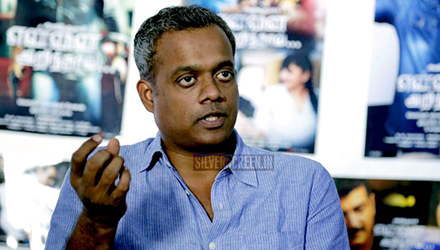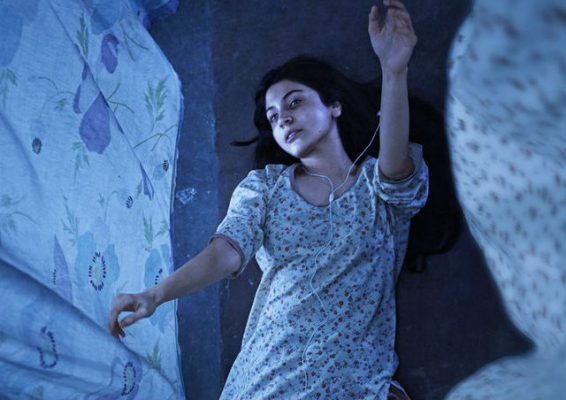 National Award-winning film-editor Vivek Harshan explains why editing is one of the ‘least glamorous, least visible jobs’ in the industry, his fondness for Padmarajan movies, and how, despite everything, what he does cannot be termed ‘clerical’.
National Award-winning film-editor Vivek Harshan explains why editing is one of the ‘least glamorous, least visible jobs’ in the industry, his fondness for Padmarajan movies, and how, despite everything, what he does cannot be termed ‘clerical’.
It’s emotional, Harshan says. “It is like listening to a song, and singing along with it.”
*****
Vivek Harshan’s studio is a squeaky clean apartment, just like his edits. Neat. Well-arranged. The only exhibit in the living room is a memento bearing the words ‘Thank You For Making Tamil Cinema Proud’.
When I tell Harshan that his work in Jigarthanda – the movie that fetched him the National Award – was fabulous, he smiles. “When you have an awesome script, a brilliant director and crew, everything becomes easy.”
Vivek Harshan is nothing if not humble.
*****
The Malayalam industry was where his career began, with those ‘new-generation’ films: Big B, Anwar, 22 Female Kottayam…
In Tamil, he chose similar ones. “From commercial entertainers like Jigarthanda and Boss Engira Bhaskaran, to emotional dramas like Bridge and Sethulakshmi, I have done it all,” he says.
But Harshan – like most other editors – adds that he join the crew only during production.
Silverscreen: Does it help if you are a part of those early pre-production sessions?
Vivek Harshan: I don’t do that. Many peers of mine don’t do that, either. It’s indeed a good thing if an editor gets involved in the pre-production part, but I find it comfortable the other way. I don’t insist on having a story board. Usually, I listen to the storyline, and sometimes, I go through the script. Then, I try to get a clear idea of what the director wants from the film. An editor’s job is half done if he manages to understand what the mood and pace of a film is.
Approximately 10 days after the shoot begins, my team collects rushes from the crew, does shoot order, and I start working on it. The editing goes almost parallel to the shoot, and by the time the filming ends, a first rough cut would be ready. I work mostly during the day, about eight to ten hours, and come back home and relax. Even when I am working on two movies simultaneously, things never get too hectic. I have a good team of assistants, and team work helps a lot. I don’t really get bored at work, but when a film doesn’t have a well-written script, or neat direction, you can’t help much. Sometimes, editors are asked to create magic out of nothing. It’s just not possible. I would tell directors, ‘If you can excite me with your script, I can excite you with my work.’
Silverscreen: So there is such a thing as a ‘director’s editor’.
VH: I would call myself one. I share a great rapport with most of the directors I have worked with. M Rajesh (Boss Engira Bhaskaran, Oru Kal Oru Kannadi, Vasuvum Saravananum Onna Padichavanga) Karthik Subbaraj, Anwar Rasheed (Bridge), Amal Neerad (Big B, Anwar)… when you know the director, it becomes easier to understand his film.
One of the films I enjoyed working in was Big B, directed by Amal Neerad, who is known for his stylised, slow motion shots. It was about a gangster, and Amal wanted novel treatment for the film. The pace was rather slow, and plenty of time was employed in showcasing the style element. The audience had never seen such a film before, and even today, they speak highly about it.
As for Jigarthanda, the mood and pace were different. It was faster, and the stories of the two characters had to go hand in hand. I was working on another movie when the shooting of Jigarthanda began. By the time the first set of rushes arrived, I joined the film, and the subsequent month was devoted entirely to Jigarthanda. In fact, I have done nothing special in the film. It had a brilliant script, which went like a roller-coaster. Karthik is such a good director that every scene he shoots turns out to be perfect. When you work with such brilliant directors, it’s tough to decide what to cut and what to retain.
Silverscreen: How do you choose between two fabulously-done shots?
VH: In Jigarthanda, I had to cut the ‘I am an artist’ scene, in which Simha had done a fabulous performance. If I hadn’t done that, the film would have had two climax-like portions. We chose the current one because it suited the commercial tastes better. Karthik was present while doing the final cuts, and we decided to go with the present climax. At the end of it all, what matters is the final output.
Silverscreen: There would have been some instances where you’d have had to edit out violence and bloodshed.
VH: The violence in Jigarthana was there to explain Simha’s Sethu. Gory scenes were required. Sethu is someone who thinks cruelty defines his existence, and I retained all the murder, bloodshed scenes Karthik had shot. I don’t think much about a film’s audience or the censor board while editing a movie. I want is my work to do justice to the film.
However, in Sethulakshmi, a Malayalam short film I worked on, the case was different. I was so overwhelmed while editing the child-abuse portions. I wanted to stop because the film was so heart-breaking. It happens when you are totally sucked into a film. The child actors were so good that it seemed the emotional pain that they were going through was real. The film turned out to be hauntingly beautiful. Sethulakshmi is one my favourite works. It begins in innocence, and later shifts to the tense, uncertain mood inside the dark room of the photo studio.
Silverscreen: Is this where an interval block would prove useful? A pause to collect your thoughts?
VH: Other countries don’t have an interval block, they call it ‘distracting’. However, it is a tradition that we follow in Indian cinema. And we like to have that ‘interval punch’, where we leave the audience hanging at a pivotal point. It’s interesting to work on that.
Also, in superstar films, we need a mandatory introduction shot, often a slow motion one, for the sake of the star’s fans. It’s neither good nor bad – that’s something we are used to. As an editor, I try to deliver exactly what the film demands.
Silverscreen: Our trailers are different, too.
VH: There are two ways of creating a trailer. One, narrating the entire story of the film to let the audience know what the film is about – most Hollywood films follow that pattern – and two, using footages from here and there to create suspense. I like the second way better. I find it more challenging and creative.
The trailer I cut for Jigarthanda turned out to be a good one. I wanted to portray the contrast between the two characters – Sethu, a violent gangster, and Karthik, a chilled-out Chennaiite. I had to convey that the film wasn’t just another Madurai rowdy story. Jigarthanda is a musical. It has romance, comedy, violence, and it sure is thrilling. The trailer summed up the movie. At the end of the trailer, when Sethu screams, “I want to find Karthik, and kill him,” director Karthik Subbaraj’s name appears on the screen. It is fun doing such trailers.
Silverscreen: An old editing practice that you wish still existed?
VH: In the past, we could spend enough time in establishing characters. But these days, the audiences aren’t patient enough to sit and watch such character-development sequences. They want the film to ‘cut to chase’ immediately.
But I try to avoid jump cuts and dissolves to the maximum. I used to employ all those flashy styles a lot, but these days, I try to use clean cuts, and focus on narration.
Silverscreen: So there is much hysteria surrounding the length of a film?
VH: Recently, I watched Baahubali, and in spite of it being a lengthy film, I thoroughly enjoyed it. I never cut a film to fit a time-frame. I first try to create a proper film, and then if necessary, trim it to fit.
Silverscreen: What does an editor get from the audience, by way of recognition?
VH: Most of them are oblivious to the editor’s contribution. Even critics, in their film reviews, use a couple of hackneyed words like ‘crisp’ to talk about an editor’s work. It is often a thankless profession. However, I have never had any qualms over it. I chose editing of all the fields because I love cinema. When you watch a rightly-paced film, with a smooth narrative, you should realise that the editor had done his work well. It’s not a clerical job, I find it very emotional.
Silverscreen: And to do that, the right apprenticeship is important, of course.
VH: Yes. I learned the nuances of film editing from an institute in Chennai and later, went on to work with Anthony sir as an assistant on eight films, including Ghajini and Vettaiyaadu Vilayaadu. Those were the best years in my life and career. He was an awe-inspiring person, a great teacher. My favourite works of his would be Ghajini and Vaaranam Aayiram.
The very first film I worked on – with Anthony sir – was 4 The People, a vigilante movie directed by Jayaraj. The way he edited the sequence in the beginning of the film was nothing less than magic. In a particular shot where policemen take oath, Anthony managed to weave in footages of them asking for and taking bribe. That’s what a good editor does – he almost rewrites the script and makes it look better on screen.
 Silverscreen: Anthony is now a director.
Silverscreen: Anthony is now a director.
VH: I will get into direction someday, too – but not any time soon. When I am directing a movie, I will entrust the editing part to someone else. Because an editor is always the first viewer of a film. Assigning that task to a different person would help get a fresh new perspective of the film.
Thrillers are a favourite, but I don’t want to stick to a particular genre. I love all kinds of cinema, and would like to experiment with the medium. And, I am a huge fan of Padmarajan movies. They are textbooks of screenplay, editing, direction, and just about everything. Thoovanathumbikal, Namukku Paarkkaan Munthirithoppukal, Season – these are the movies I grew up watching. That kind of selfless romance and heroism is what I miss in the films these days. I would love to work on one such movie – deeply emotional, well-scripted, slow-paced and memorable.
Silverscreen: Films that offer great lessons in editing?
Recommended
VH: Requiem For a Dream. It’s an all-time favourite. It’s the kind of film that takes off from a particular point, and ends somewhere very different. It takes you on a journey, the destination of which you have no idea about. There is a special kind of rhythm, especially in those psychedelic sequences.
Similarly, I love David Fincher’s Seven, Sujay Ghosh’s Kahaani, and Michael Mann’s Public Enemies. Of all genres, I love thrillers the most. It’s tough to pull off an edgy thriller like Seven and Kahaani – to make the right cuts, and build the dark mood. Doing cuts for such films is like listening to a song, and singing along with it.
Sreekar Prasad, KL Praveen, and Kishore are some of my favourite editors. Praveen’s Madras is one of the best-edited films in recent times.
*****
The Vivek Harshan interview is a Silverscreen exclusive.


